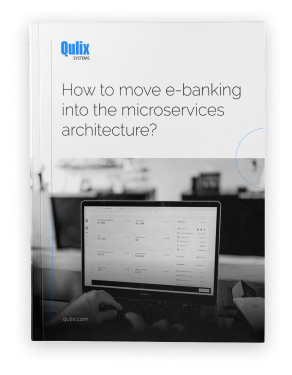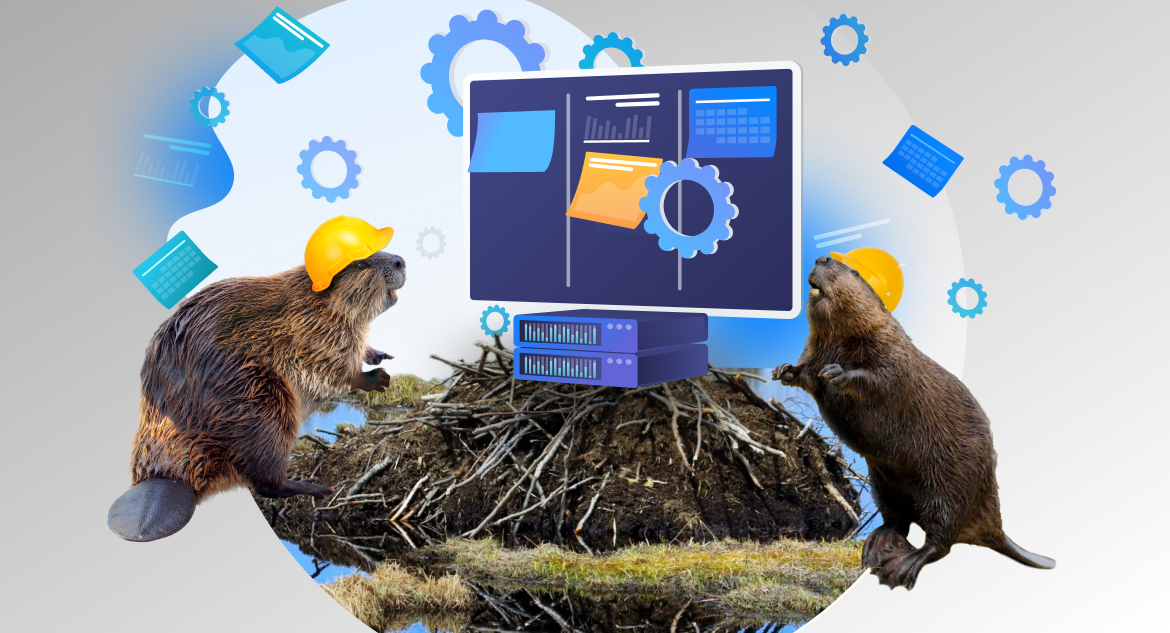Knowing how to build enterprise software in today’s business industry is the key to skyrocketing to success. By 2025, the Enterprise Software Market is expected to be worth $545 million, and for many good reasons. It is able to improve the efficiency of your employees, increase revenue, and enhance your customer's experiences. In addition, enterprise software is fully customizable to your company’s needs.
Building one may seem like a daunting task, but no worries, in this article, we're going to answer all your questions and tell you the steps you need to take.
written by:
Pavel Mazko
Solution Architect
Contents
What Is Enterprise Software?
Enterprise software is designed for large companies, or businesses, as opposed to individuals. It addresses essential communication problems and includes functions that minimize redundancies, facilitate internal communication, and overall improves the work life of employees. Customer support, market research, and sales are just a few of the responsibilities enterprise apps cover. This software is intended to handle a big number of requests whilst servicing numerous users and is the smartest method to have centralized control over your corporation.
Enterprise apps can help your organization to:
- Coordinate project management across multiple departments;
- Provide more opportunities for data collection, storage, and analysis;
- Minimize the chance of human error by automating processes;
- Empower managers with more control over day-to-day operations;
- Bring mobility to the workplace;
- Increase throughput and efficiency.
Why Should You Build an Enterprise Software Application?
Boost Customer Experience
The adoption of an enterprise application helps your business in many ways, but in reality, the benefits extend past your company to improve customer experience. When all client data is centralized, the organization can gain better knowledge of its users. It helps businesses to provide customized services to individual clients. As a result, they contribute to the development of solid and long-lasting consumer connections.
Decrease Liabilities
Enterprise software can aid in reducing wasteful expenditures and identify areas where efforts are ineffective, by monitoring all operations within your business.
Improve Workforce Efficiency
When you automate business processes, the burden on your employees is significantly reduced. This is because the effort previously required for them to complete repetitive tasks demands less time. It frees up their day to concentrate on critical business operations, such as marketing and HR, allowing them to provide more value to the company.
Increase Revenue
Once you have established an efficient system for your business processes, it will become much simpler to increase your revenue. As a result, your company will be able to serve a greater number of consumers, all while reducing wasteful expenditures.
Keep Up to Date
As your company expands, it becomes more difficult to keep track of every element in your everyday operations. Consequently, this could result in unanticipated expenditures, missed payments, and delays. An enterprise app will assist you in identifying errors that are impeding the growth of your firm.
Financial Performance Activities
Once you have a company that is constantly growing, it can be difficult to keep track of all the transactions that occur on the web page. By creating an enterprise application, it helps with monitoring all operations, tracking timelines, reminders, and so on. You can also add alternative payment options, depending on your company's specifications and objectives.
Types of Enterprise Software Applications
When it comes to building enterprise software, you need to know the types of enterprise applications out there. This way you can fully understand which type will be the best fit for your company and proceed from there.
Analytical
Enterprise analytics consists of accumulating, analyzing, and interpreting immense quantities of information in order to derive insights that help businesses make quicker and smarter decisions. These analytics can give you insight, create perspectives, forecast future situations, and guide individuals. This is done by utilizing a variety of approaches such as data retrieval and analysis, forecasting, trend evaluation, and visual analytics.
In fact, enterprise analytics can support major corporations through identifying gaps in their user journeys while also recognizing developing patterns. Since large companies deal with higher quantities of data, enterprise analytics focuses on cutting through the confusion to get to the valuable information.
Through specifying your key metrics and KPIs across one unified platform, you guarantee that every team and department are aligned to your corporate objectives.
After you've established these KPIs, an enterprise analytics platform can assist with monitoring customer journeys and activity on the platform using tools such as heatmaps and polls. Analyzing inbound advanced analytics from a unified platform removes fragmented data, aiding your companies’ optimization efforts.
Collaborative
An enterprise collaboration system is a database that collects, interprets, archives, and generates reports across corporate employees. It's an all-in-one site where team members can interact and maintain records of assignments.
This collaborative software is intuitively accessible 24/7, and updates instantaneously, leading to improved teamwork, productivity, and morale. There are two main types of collaborative enterprise systems:
- Customer Relationship Management (CRM) is an essential tool for the growth of your brand relationship; it allows you to keep in contact with current and prospective customers, optimize procedures, and maximize profits.
- Content Management Systems (CMS) are pieces of software that enable people to generate, maintain, and alter web content without requiring technical skills.
Management
Management applications represent one of the most important corporate software application types. Still, this is quite a general definition, since this software can be used in various areas throughout an organization. Let’s go through the spheres of HR, ERP, and CRM where management apps truly shine.
Business Management Apps
This sort of program is primarily designed to boost corporate efficiency. Apps like Nintex, MDM Software, and Promapp, will connect with the organization’s current structure and optimize productivity from the ground up.
Enterprise Resource Planning (ERP) Apps
ERP applications are designed to organize and combine various elements of a company into a single app. Organizing, cost management, advertising, development, and stock acquisition are all just a handful of the numerous functions of ERP. Well-known companies who use these types of applications are Ikea, Nestle, and Nike.
HR Management Apps
HR software aids a company's human resources department by streamlining everyday tasks, organizing employee data, and producing statistical insights. This software can also benefit staff members and managers within a business with duties such as time monitoring, personnel directory updates, and performance evaluation. The program enables HR staff and management to better allocate their time and resources to more productive and beneficial efforts.
Storage
Enterprise storage is a comprehensive database for corporate data that enables data sharing, processing, and security across several computer networks. It outperforms standard storage alternatives in terms of efficiency, reliability, and flexibility. Depending on the software, it may consist of a storage area network (SAN), network-attached storage (NAS), or software defined storage (SDS). They make sure all data is connected via duplicate pathways, guaranteeing accessibility to vital information in the case of a crisis or equipment failure. Enterprise storage is used by large companies for high reliability, incident management, cross-platform information exchange, and data backup and restoration services.
How to Build Enterprise Software
Now that you know the various types of enterprise software, let's get into how to actually build one yourself.
1. Create a Blueprint
Develop a clear strategy that covers your project management plans, dates and time frames, cost projection, and other software needs prior to beginning enterprise software development.
Project Plan: Create a written plan for the enterprise software you intend to develop. The plan will aid in the identification of development tools, scripting languages, and platforms that will influence the software's future.
Dates and Time Frames: Establish reasonable timelines and enlist the help of qualified specialists. This will show you just exactly how much time is required to create and deploy the software.
Cost Projection: Before starting the project, make sure the software is reasonable and cost-effective, to avoid any unnecessary spending.
Software Prerequisites: Make a list of everything you'll need to get started on your development. Be sure to include specialists, equipment, technology, as well as other resources that may be needed.
2. Examine the Project Scope
At this point, you must confirm that all software requirements are documented and acknowledged by all parties. Organize team meetings to make sure they're aware of the schedule, resources needed, and certain other software aspects. Put together an official paper with all the necessary elements and collect as much information as necessary.
You can examine your project's requirements comprehensively by doing the following:
- Study your current software to get a full understanding of how it works.
- Hold workshops and talks with consumers and programmers.
- Gather user data through surveys and online tests.
3. Pick the Appropriate Technology
To create the best enterprise software, you need to pick a suitable developer tech toolkit:
Most businesses now run their ERP systems in the cloud or on a local server, because it is regarded as more reliable. JavaScript frameworks are ideal for front-end development, whereas Node.js is ideal for back-end development. There is also the Java EE platform, which is intended to simplify corporate app creation by offering a development paradigm, API, and runtime framework which enables developers to focus on functionality. Based on your needs, choose a dependable database for storing large amounts of data. Relational/SQL databases are ideal for small enterprises with a high requirement for consistency.
4. Find a Competent Team
Finding the optimal talent pool for business software development can be difficult, but it's not impossible. It's within your best interest to get a team of specialists who can handle the entire procedure intelligently and effectively. Once you do, you can rest easy knowing that the development hurdles, data migration, and transitional phase are managed by a team of experienced ERP implementation specialists.
The best skilled team consists of:
Project Manager
plans, coordinates, prepares, executes, and manages the whole development process.
QA Specialist
responsible for the quality of the development process, ensuring the final product is bug-free.
Enhanced Security
writes/creates software by providing particular programming commands to the computer.
Analyst
in charge of monitoring and managing a company's technical content and application programs, assuring effectiveness and desired performance.
DevOps Engineer
IT specialist whose mission is to combine and optimize software development and IT operations.
Consultant
acts as a liaison between the IT and business sides, reviewing systems, defining goals, providing advice, and reporting to management.
5. Software Design
The majority of software initiatives are either poorly conceived or badly managed. Make sure your idea is practical and engaging when creating and developing your enterprise apps.
Once you've identified your software objectives, the creative process will be a breeze. The feedback you've previously obtained from users will guide you in tailoring the program to your specific company needs. For best results, develop a prototype before finishing your design and distribute amongst the parties for feedback. Just because your software architecture might be complex doesn't exempt it from making it user-friendly.
6. Software Building
After you've established your development technology toolkit and software design, your hired team of professionals can now begin programming in accordance with the project's SRS (software requirement specification). Remember that it is critical not to rush through the development process, as this can lead to unexpected obstacles or inefficiencies.
Finding the correct balance between software quality and commercial value is critical when developing enterprise software. Any potential bad decision could make matters worse and send objectives in the wrong direction.
7. Software Quality Assurance
It is of the utmost importance that you properly test the program before delivering it to users. To avoid running into any issues, you need to test the program in various ways to remove any errors or glitches. There are several software assessments to guarantee that your software works flawlessly.
- Code Quality: Reduces defects and crashes to provide perfectly clear code that is legible and simple to modify as needed.
- Unit Testing: This test identifies numerous components to ensure that each software unit works as planned.
- Integration Testing: This identifies any faults or gaps in the functioning of integrated elements. All items are checked to assure proper operation.
- Performance Testing: This test identifies and removes software system failures. Coders then test the software's performance, reaction time, dependability, resource consumption, and scalability under the projected demand. They also ensure that the program runs properly even when several people access it at the exact same time.
- Security Testing: This is performed to identify any harmful threats, weaknesses, or dangers. It finds security flaws in software and fixes them through code.
Once you have put your enterprise apps through these testing processes and successfully completed them, it's now set to be deployed.
8. Software Deployment
After completing all the previous steps, your enterprise application is now ready for market release. The deployment method is purely manual, with the software being deployed only after receiving manual authorization.
Several organizations use automated solutions to distribute software, such as Application Release Automation (ARA). After making the program accessible to staff members, you need to train them on how to use it. After all of this, your newly built enterprise software will be released effortlessly.
9. Support and Upkeep
Following a successful launch, you must regularly check the program to assure its faultless performance. There is always room for improvement, so the program may be modified and changed based on user input.
Frequent tests will also reveal any problems or flaws in the program that may be impeding its performance. Finding the flaws is the first step, and it's critical to remove them in order to avoid future software issues.
Features to Focus On
Not everything is a "one-size fits all" situation when it comes to building enterprise apps. Nevertheless, there are certain features that you might want to prioritize to make your business processes more efficient.
Comprehensive Database
Since enterprise apps are, at their core, a corporate system, they are intertwined with user data and data flows. An enterprise database is where all of this data is held. Another way to envision this is to imagine that databases are groups of tables that include data pertaining to individuals, products, and assets, including all of their traits and attributes.
Because database information is always changing, the tables must be flexible and trustworthy. Databases must also be constant across different platforms and devices, with no delays or downtime.
Multiple User Roles
Enterprise apps are designed to benefit various users inside a business, but not all the data in the app should be accessible to everyone. Multiple user roles are intended for this purpose. They grant authority to specified groups of users to complete specific actions and access a particular segment of the business app's data.
Compatibility with Third-Party Apps
Building enterprise applications without collaborating with other programs is nearly impossible. Let’s say you’re currently using Jira for project management, Google Docs for editing, and other programs for business processes. You don't need to recreate these types of applications, instead, take advantage and collaborate with them, while using your enterprise app.
Instant Messaging (IM)
One of the aims of an enterprise app is to create a space for employees to engage with one another. Including chat capabilities into your corporate software is a great idea since it enables for easy interaction between employees while also keeping track of previous modifications to specific files.
Real-Time Analytics
An enterprise app is a platform for countless people to engage on a daily basis. This is particularly true for offsite team communication. To eliminate data processing glitches, your corporate program must be able to update in real-time to avoid any mishaps.
Challenges of Enterprise Application Software
Building an enterprise software application isn't a walk in the park, as there are certain challenges you'll most likely face. However, knowing them in advance helps you to be prepared to tackle them head-on.
1. Company Expansion and Rapidly Evolving Environment
It's common knowledge that the objectives of businesses and their environments are forever evolving. It might be as a result of new technology, economic growth, or just upgrading on the services they offer. Therefore, one of the most difficult issues in enterprise application development that the majority of developers confront is incorporating new standards and processes. The architecture of enterprise software is complicated, and every effort at making modifications must be consistent with the others.
Therefore, you should create a scalable and adaptable framework. A modular architecture is one answer to this problem, because any modifications made to a single module have no effect on the functionality of other modules. This could assist the company's enterprise application to save time and avoid prolonged outages.
2. Expenses and Time
The process of creating an enterprise application can be time-consuming and expensive. It might take 5–6 months to build if the methods and strategy are not clear from the get-go. This is why companies must prepare ahead of time before building an application.
Knowing what type of software you want will save you both money and time in the long run, since you'll know precisely what functionalities you require. Additionally, you should consider alternative solutions which could cut development time and expenditures. Utilizing technologies such as cloud computing, DevOps, and others can help you save money down the road later.
3. Increasing ROI
A very common enterprise apps issue is encountering low return on investment (ROI), because this software takes months to develop and costs a pretty penny. This means that it's absolutely critical to meticulously organize the production cycle and guarantee that all aspects and criteria are exact. Careful preparation will assist the development team in predicting the time frame and cost. Which can then save consumers from losing out of funds before the project is complete or from delivering a product which fails to fulfill all objectives.
Therefore, you should explicitly organize the development process, establish priorities, and evaluate on a periodic schedule to ensure that all pieces and functionalities are accomplished.
4. Integration of Third-Party Systems
Another frequent challenge in enterprise application development that many businesses confront is the integration of multiple apps. Enterprise applications are mostly produced by companies to streamline all corporate operations, so shareholders anticipate that their software will be used by a range of enterprises and customers. Corporate software must thus offer a variety of services, which calls for the integration of other programs.
Businesses must specify their aims and criteria prior to starting any type of development. If there is an application on which your business heavily depends, let the programmers know and keep track of the product's scalability requirements and range.
At their core, enterprise apps are created by businesses to consolidate all business activities, which means shareholders expect their software to be applicable to a variety of organizations and consumers. As a result, corporate software must provide a variety of services, necessitating the integration of third-party applications.
Before beginning any sort of development, businesses must define their objectives and criteria. Keep track of the product's scalability specifications and range, and inform the programmers if there is an application on which your business substantially relies.
5. Large Quantities of Data Storage
The storage of enormous data sets is a major enterprise application development problem. It is difficult to handle due to large computing infrastructure, bandwidth, and storage rates, which can impede the database's rate of response and loading time for consumers. This is especially true for global scale firms or big clients.
Therefore, it is critical to encourage the business and consumers to filter down datasets like reminding them to clear out obsolete data, on a regular basis. You could also use a cloud-based storage or a third-party database management program.
6. Management and Security
Cyber security threats are among the most common application development challenges that a firm faces. Enterprise software deals with sensitive information such as company procedures, proprietary information, customer data, and so on. Having security increases software trust as well as oversight for both users and enterprises.
At the server and network levels, a solid defensive mechanism, including firewalls and encryption, must be in operation. You have to verify that your corporate apps can address any security flaws that may pop up.
Also, frequent sensitivity testing of the program should be performed to identify any flaws that hackers may exploit. Businesses should also deploy security fixes frequently to keep up with the latest technologies.
7. Recruiting and Training Employees
Many businesses overlook the fact that workers are the ones who will utilize the enterprise application once it has been created. It's easy to get carried away and install a bunch of fancy features that, in reality, the employees have no use for. This results in your staff being unaware of their obligations or the proper use of the software.
The best course of action would be to train the employees and provide them with a detailed outline of the program and its functions. Then, demonstrate how they can make use of the software in their daily activities. Finally, present them with a collection of sources, such as seminars and manuals, for furthering their knowledge of the application.
8. Simple Interface
Building an engaging and user-friendly layout is one of the most typical corporate application development problems. Often, the software interface is crowded with elements that people are unfamiliar with, which results in employees struggling to use it. If the potential users do not find the program useful or straightforward, it all goes back to the developer, and they need to start from square one.
Similarly, it is essential to always specify the customer experience in the application. You need to concentrate on the importance of designing a layout that is both useful and simple to navigate for average consumers. Make certain that your program delivers a nice user experience while also being quick and efficient.
9. Upgrade Outdated Software
Instead of creating a new enterprise application from scratch, you might consider upgrading your current software. Some businesses want to keep their legacy enterprise software, but going down this path presents new problems.
The vast majority of old software is incompatible with other systems and does not fulfill business or regulatory standards. It's significantly more difficult to maintain, and it regularly crashes, making the addition of new functions and features impossible.
Before embarking on your plan to upgrade, the old software must be thoroughly examined. The choice should take into account aspects such as how big your team is and the intricacy of the software. Furthermore, a well-thought-out structure and common enterprise application languages that enable both flexibility and modifications after creation are necessary.
10. Upkeep
When building enterprise software, maintenance is just as important as the software itself. Although of course not the main concern, your enterprise application must be adaptable to changing circumstances and requirements.
The use of modular architecture in enterprise software makes upkeep duties simpler to supervise, as it makes it manageable to maintain and modify software.
FAQ
1. What is enterprise software?
Enterprise software, often known as enterprise application software (ESA), is a computer program that is designed to meet the needs of a company, rather than independent users.
2. What are types of enterprise software?
The four main types of enterprise applications are analytical, collaborative, management, and storage.
3. What is the most important benefit of an enterprise application?
There are many benefits when it comes to enterprise software solutions, but arguably the most essential one is being able to streamline your business processes.
4. How do I create an enterprise application?
The first steps to building enterprise apps is to create a blueprint, examine the project scope and find a reliable team to develop it. Once that’s done, you can move onto designing, building, and assessing it to make sure everything looks and functions the way you want it to. The final step is to deploy your software and maintain upkeep on it to make sure everything is running correctly for your business processes.
5. What are some application trends for enterprise resource planning?
Although it's not entirely possible to have a quick look at the enterprise software industry overview, these examples should provide you with a bit of an insight:
- Microservices — an app architectural type that is a collection of interconnecting services.
- Cloud-based services — improve software application development by simplifying microservice administration and deployment.
- Big Data — assists in the systematization of vast volumes of data and the acceleration of business operations.
- Artificial Intelligence — accelerates your app's internal operations by speeding up data extraction, tag categorization, and streamlined search.
6. What are three types of hosted enterprise software?
The three types of hosted enterprise software are customer relationship management, supply chain management, and enterprise systems.
Ready to Get Building?
Having a large, successful company is the dream for many people, but it can quickly turn into a nightmare if it's not properly managed. That's the beauty of enterprise apps. You can rest easy knowing every piece of data is secure, all your marketing campaigns won't accidentally get deleted, and your business processes are good to go. You'll be glad you made the investment when you create your own business process management software and see all the amazing benefits.
If you are looking for assistance in creating your own enterprise software application, Qulix will be happy to help! Contact us to find out more or visit our website.

Contacts
Feel free to get in touch with us! Use this contact form for an ASAP response.
Call us at +44 151 528 8015
E-mail us at request@qulix.com











